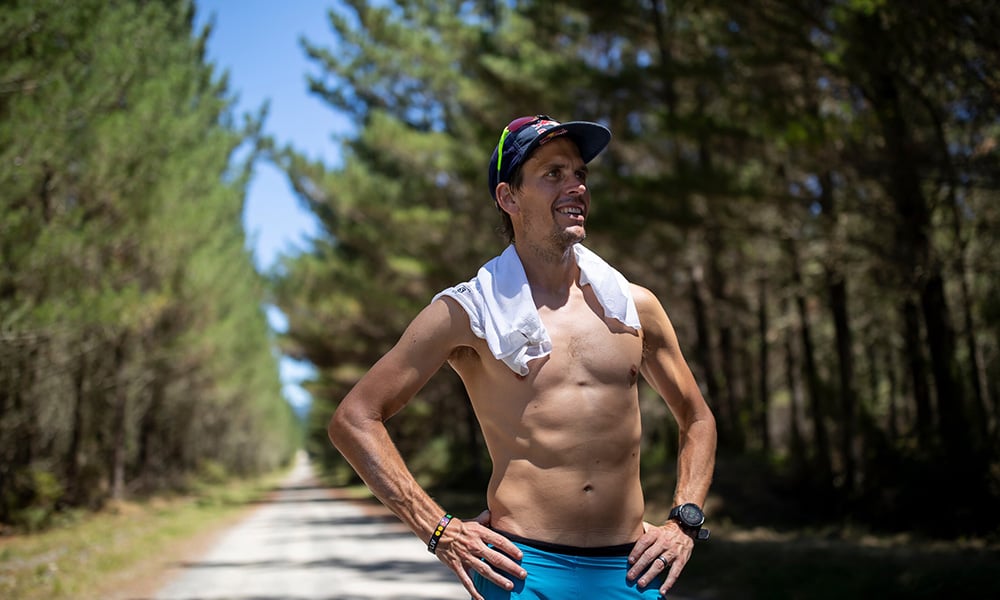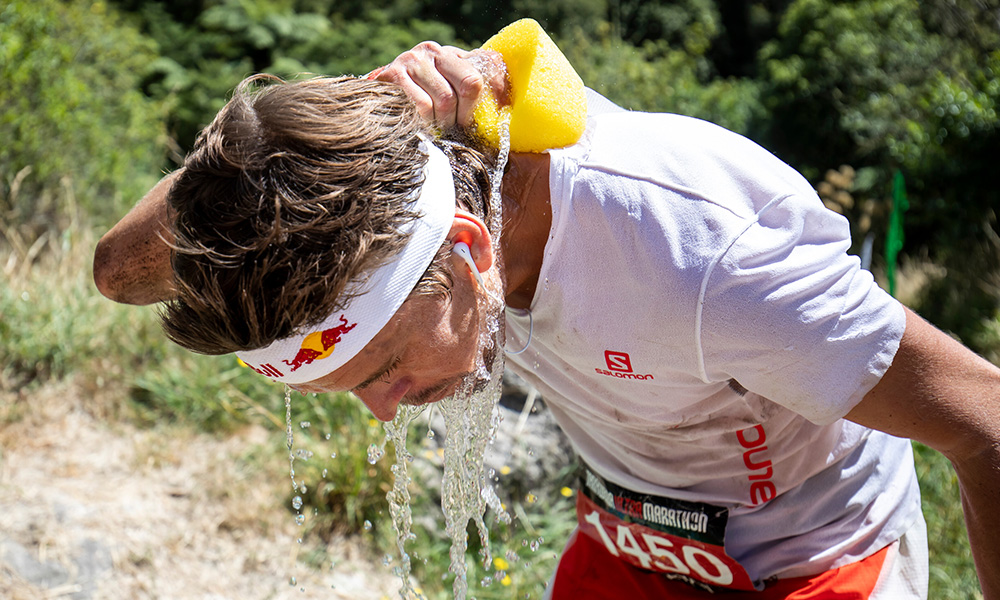
Ryan is specialist at running in heat. © Graeme Murray / Red Bull Content Pool
When Ryan Sandes ran across the Sahara Desert in 52°C heat, it felt like he was running with a paper bag on his head. “It doesn't feel like you can get enough air in,” he say. “Everything you breathe is super hot.”
The South African ultra champion competed in the Four Deserts Race, including the Sahara, Gobi, Antarctica, and Atacama deserts, placing first in three, and second in one. He’s also run in the deserts of Madagascar and Namibia, the insane Jungle Marathon in Central America, as well as in 45°C on the epic Western States 100 Miler, where he placed first in 2017. Needless to say, Ryan has learned to handle the heat – here are his seven tips.
“Heat has a huge effect; it makes you a lot more tired, and move slower,” Ryan says. “Mentally, it's also harder. The good news is the body does adapt to heat really well.”

Take every opportunity to cool your core temperature. © Graeme Murray / Red Bull Content Pool
Before race day
Cultivate acceptance
Whatever the challenge, whether struggling with altitude like he did when he and Ryno Griesel set the fastest known time on the Great Himalayan Trail, or enduring intense humidity in the jungle, acceptance is essential for mental toughness, Ryan says. “Running in the heat is not only a physical challenge, but also a mental one,” he says. “You have to accept it and realise it's going to be tougher. It's like running at high altitude; you are going to have the physiological restrictions, and you’ve got to accept that and make peace with it.”
Click to read Ryan's five life lessons he learned on the Great Himalayan Trail
Benefit from simulation
When Ryan prepared for running across the Sahara Desert he trained in an environmental chamber at the Sports Science Institute of Cape Town. He ran on a treadmill in the small room for an hour or two, while coaches adjusted the temperature to match that in the Sahara. “It gave me a lot of confidence that I could run in those temperatures,” he says. “I think a lot of it is about not panicking, being at ease with the fact it is going to be difficult. That training helped a lot.”
Not many of us have access to an environmental chamber. If you don’t, then Ryan recommends having saunas a couple of weeks before your race. “Get into a sauna or steam room daily or every second day and just sit in their or do a couple of light exercises,” he says.
Another way to simulate, is to wait for the afternoon sun, then put on some extra layers of clothing and head out for a run. “Get the body sweating and being more efficient in the heat,” Ryan explains. “You pick it up quite quickly, but you also lose it quite quickly. Just focus on doing this two to three weeks out from the event.”
Have a plan
Before the race or training session, create a plan for how to keep yourself hydrated and as cool as possible. Think carefully about how much water you need to carry, where on the route you will be able to refill your water supply, and also when you might be able to cool yourself down. “Try to figure out how much water and electrolytes you need in your training,” Ryan says.
During the race
Regular water stops
“At the Western States 100 Miler there are a lot of aid stations long the way,” Ryan says. “Take some extra time at aid stations to make sure you are getting in enough liquids and electrolytes. While you’re there, use ice, or cold sponges, or an ice hat if you have one.”
Stay cool
Ryan recommends wearing an ice hat, or ice neck and wrist wraps to help stay cool. When you pass by a stream or lake, take a dip whenever you can. Another trick is to wear light weight attire made of fabrics that hold some moisture. As you run and the air passes through the fabric, the moisture will cool. “When your core temperature gets too high it slows you down,” he says. “If you can control that it’s a big help.”
Take electrolytes
“Don’t drink too much water without replenishing your electrolytes,” Ryan says. “Different people sweat out different amounts. The more you get used to running in the heat and the sun, the more efficient you become in how much you sweat and your electrolyte use.”
Protect yourself
A hat, sun glasses, sunscreen and lip balms are all essential items to protect yourself from the sun. “If you get sunburn early on that can be the end of the long run,” Ryan says. “When you sweat a lot, you chaff a lot more so I also use Squirrel’s Nut Butter underneath my armpits, on my nipples, and around my groin.”
Lead image: © Graeme Murray / Red Bull Content Pool
Click below for more running tips!
Learn how sleep can make you a better runner
7 principles to help you find the flow







